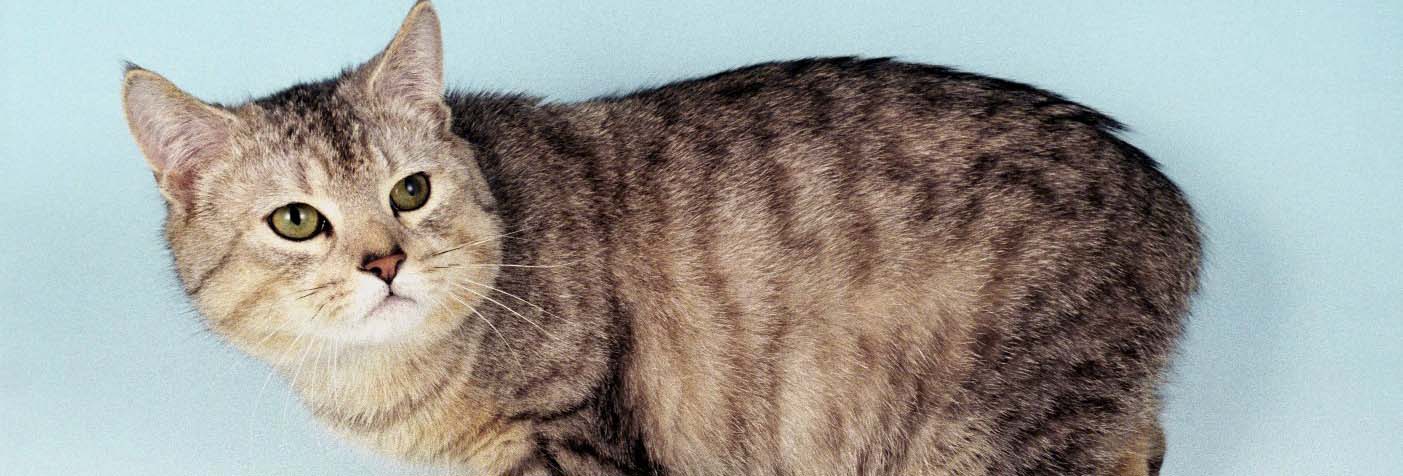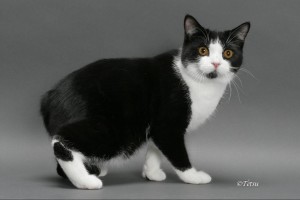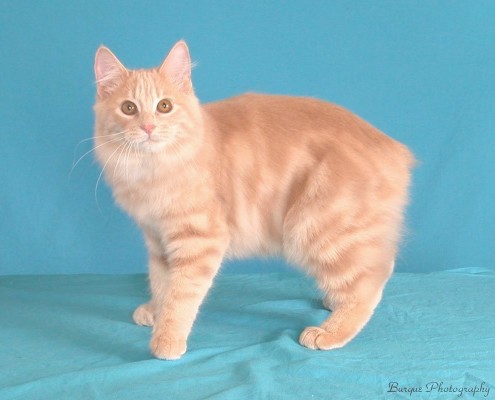Manx

Meoww!!
One popular myth is that the Manx was late getting onto Noah’s ark and Noah accidentally slammed the door on its tail.
In 5 Words
- Friendly
- Affectionate
- Loyal
- Intelligent
- Active
Snapshot
WEIGHT RANGE:
Male: medium: 8-12 lbs.
Female: medium: 8-12 lbs.
EYE COLOR:
Amber, Copper, Green, Gold, Hazel, Orange, Yellow
EXPECTATIONS:
Longevity Range: 9-13 yrs.
Social/Attention Needs: Moderate
Tendency to Shed: Moderate
COAT:
Length: Short, Long
Characteristics: Straight
Colors: White, Blue, Black, Red, Cream, Silver, Tortoiseshell, Bluecream, Brown
Pattern: Solid color, Tortoiseshell, Bicolor, Tricolor/Calico, Tabby, Ticking, Smoke, Shaded
Less Allergenic: No
Overall Grooming Needs: Moderate, High
CLUB RECOGNITION:
Cat Association Recognition:
CFA, ACFA , FIFe, TICA
Prevalence: Rare

Characteristics
Learn About the Manx
The Manx is an ancient breed. There is some disagreement about its exact origin, which is the subject of theories ranging from plausible to fairy tale lore. Some fanciers believe that the Manx descends from cats that swam ashore from a shipwrecked Spanish galleon, landing on the Isle of Man off the west coast of mainland Great Britain in or around 1588. Many people think that the Manx descends directly from cats that were native to the Isle of Man. In any case, tailless cats have lived on that island for hundreds of years.This cat’s mysterious beginnings are anything but boring. One popular myth is that the Manx was late getting onto Noah’s ark and Noah accidentally slammed the door on its tail. Another popular folklore speaks of Manx cats swimming ashore from the wrecked galleon of the Spanish Armada in 1588. But the more commonly accepted theory is that this breed originated on the Isle of Man, located off the coast of England, several hundred years ago. The first Manx champion was named Bonhaki. This silver tabby Manx achieved this honor in London around 1900. The Manx has been bred in the United States since the early 1930s and the first United States Manx grand champion was awarded in 1951.
The Manx cat moves rather like a rabbit. It is a solid and compact cat of medium size. The head is large and round with prominent cheeks, and the nose is broad but straight and the ears are quite large with rounded tips. The ears are set high on the head and are angled slightly outwards. They taper from a broad base to a rounded tip. The eyes are large and round and the eye colour is in keeping with the coat colour. The body is compact and solid, with a broad chest and short back. The rump is rounded and should be higher than the shoulders. The legs are short and powerful, with the back legs being slightly longer than the front. In the show cat there must be absolutely no tail and the rump should be completely rounded but stumps of varying lengths are allowed in the breeding or pet cat.
The Manx is gentle and playful. It’s not unusual to find that he enjoys playing fetch or carrying his toys around. He’s also smart and dexterous, capable of using his paws to get into cabinets or to open doors. the Manx is a friendly, affectionate, loyal breed. It is known for its keen intelligence and personable nature. Manx cats make great household companions. They are intelligent, active, and fun-loving cats that manage to express themselves very well without tails to swish around. Manx get along well with other pets (particularly dogs), and form strong bonds with their chosen humans. They enjoy a good game of fetch and are fascinated by water, but only on their terms, of course. Manx are exceptional jumpers because of their powerful back legs. No cupboard or shelf is safe with a Manx around.A working cat breed, the Manx can live in either outdoors or indoors and is an excellent hunter. Because of their easy-going nature, they make ideal pets for children.The Manx is highly intelligent. Challenge his brain and keep him interested in life by teaching him tricks and providing him with puzzle toys that will reward him with kibble or treats when he learns how to manipulate them.
Both pedigreed cats and mixed-breed cats have varying incidences of health problems that may be genetic in nature. Manx are generally healthy, but the following diseases have been seen in the breed:
- Arthritis of the tailbone in cats with partial tails
- Corneal dystrophy, cloudiness that begins to develop when a kitten is approximately 4 months old
- Manx syndrome, a collection of birth defects that may include a spine that is too short, urinary tract defects, and problems with the bowels and digestion. The condition affects approximately 20 percent of Manx cats, most often rumpies, and usually shows up by the time a kitten is 4 months old, a good reason to wait until that age before bringing a Manx kitten home.
– The soft, short coat of the Manx is easily cared for with weekly brushing or combing to remove dead hair and distribute skin oil. Check the rear end closely to make sure feces aren’t clinging to the fur surrounding the anus, and clean it if necessary to prevent the cat from smearing poop on carpets or furniture.
– Brush the teeth to prevent periodontal disease. Daily dental hygiene is best, but weekly brushing is better than nothing. Wipe the corners of the eyes with a soft, damp cloth to remove any discharge. Use a separate area of the cloth for each eye so you don’t run the risk of spreading any infection. Check the ears weekly. If they look dirty, wipe them out with a cotton ball or soft damp cloth moistened with a 50-50 mixture of cider vinegar and warm water. Avoid using cotton swabs, which can damage the interior of the ear.
– Keep the litter box spotlessly clean. Like all cats, Manx are very particular about bathroom hygiene.
It’s a good idea to keep a Manx as an indoor-only cat to protect him from diseases spread by other cats, attacks by dogs or coyotes, and the other dangers that face cats who go outdoors, such as being hit by a car. Manx who go outdoors also run the risk of being stolen by someone who would like to have such a beautiful cat without paying for it.






